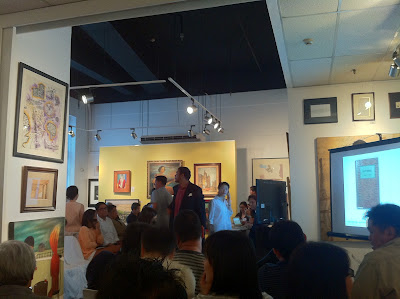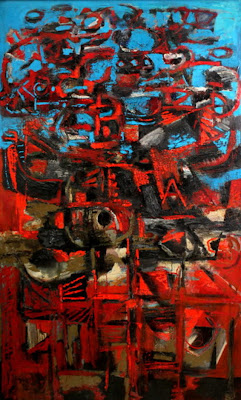By: NBA
The art world is
often associated to a niche market. A market that is well-segmented to the wealthy
personas and to the erudite ones -- the elites. In a third world country like ours, pricey artworks are regarded as
treasures and a rich man’s “quirks.”
A good number of
successful people’s wealth is rooted from putting capital into traditional
investments; in the form of stocks and bonds. Majority of them chooses this type as it proves to be less risky
compared to other nature of investments.
However, there is that growing cluster of elites that goes outside the
normal realm of finances; they settle to alternatives such as real estate, coins,
cars, wines and for this matter – the fine
arts.
This article will explain the perfect symmetry of the elites and their connection to fine arts. What instigated them to see art in an unusual way? Alongside the fact that
they can afford anything to their liking, rich people didn’t get rich because of
their caprices. Most of them have
accumulated their wealth because of wise and sound financial decisions they have made.
But the question now is why art? why do the elites invest in it?
Diversified Investment Portfolio
Any millionaire can attest
to the general rule of spreading out your capital, Fine art, however, seems to
be the more exciting option for elites.
As the editor in Economic Times said, “Art is one of the few tangible assets that also qualifies as a ‘passion
investment’. There is more enjoyment in displaying art on your wall than in
displaying stock certificates.” Sure, they have seed capital elsewhere too like real estate or the stock market. But with art, they get to serve what the economic
irony of “wants” and “needs” dictates. They get to broaden their horizons in terms of investment by spreading their capital; thus, reducing the risk for loss.
However, treating art
as an investment entails a deep knowledge and dedication to the trends in the
market. Serious art collectors sometimes seek advices from
experienced art connoisseurs to gain insights into picking a certain type of
painting or sculpture. They read society pages, attend countless exhibits and observes the whole scene if need be.
Earn later on
The world economy has
never been so unpredictable; stocks, bonds, currency exchange is in a state of
flux more than ever. Most
investors would rather put on their money with something pleasurable and
valuable such as buying paintings. Being endowed with wealth, they have the ability to acquire possessions and the luxury of time to reap off the benefits of their action. Just like how other groups channel their extra money to 'pre-selling condos' or barren lands, this type of investments will pay off in time through appraisal. Fine Art, on the other hand is given the same treatment, art investors amass pieces they believe will appreciate through time.
An overtly wealthy businessman collects the works of the
masters – those with offbeat prices that sets our pulse rising. This type of collectors are the
conservative ones, they go for the tried
and tested. Their goal is to
acquire pieces of high value already, that later on could still command price in
the market.
On the other hand, there
are those young bloods who go for contemporary artists – these group aims for a great return of their money later on as the career of the artist ripens too
(provided that they have made a good prediction). They belong to the movers
and drivers of the art
world. They support the art scene,
rubs elbow with the gallery owner and boasts of their growing collection of
young artists. Dr Sarah Thornton, author of Seven Days in the Art World cites in his book,
“Collections are more likely to increase
in value if they are seen by the general public because art accrues value
through exposure. This is particularly important with contemporary art, where
the reputations of these artists are still being consolidated.” That is why they enjoy being photographed in art exhibits that will later on grace the lifestyle section of the newspaper.
After all, their mere presence produces prestige simply by
association with wealth. They
manipulate the “market” and set the parameters. The result -- prices of the pieces they own would go to unprecedented heights and give them a huge amount of money compared to what they have shelled out. After all, a businessman always knows where to put his money and does everything to make it earn.

For the majority of elites, acquiring a piece of painting not only adorns the pristine walls of their mansions but also serves as investments that could lead on to the next generation’s wealth. There’s this notion of ‘pamana’ that we all know is only germane to the Filipino upper class. Most parents prefer to hand down properties and tangible items over an amount of cash in the bank, simply because it is more sentimental to begin with. In the case of art works, possessing a family heirloom gives more value to the painting (such provenance can be given).
Start
a Collection
When
one starts to get a hold of what interests him and focuses on it, he would most
probably start a collection.
Elites chooses a collection that they can take pride in their sphere. It is not new to hear wealthy men
paying a hefty amount of money for some vintage cars that they treat like
babies or a group of businessmen boasting about their hundred year old wines
stored in their fancy bars. Collecting art is one of those that belonged to the
circle of class. A lot of these
elites have different styles of collecting art and they are more than willing
to spare hundreds of thousands to get a good piece. When an art
enthusiast starts acquiring pieces in his early years, he then grows with his
collections. He will grow
accustomed to its beauty and hang into it. These possessions now become even priceless to him.
Once people own something, they start to
ascribe value to that object simply through having owned it and that means that
they are not willing to sell it at the same price for which they would buy it,”
(Economic Times).
Social Status
For most Filipino middle-class citizens, the price of a small-framed art piece of a reputable artist can drive them nuts. An average pinoy developed an allergic reaction to art galleries, auction houses and art gala events mainly because of its extrinsic association to high prices and suave galleries. It’s Juan’s hors d'oeuvre or aperitif to his ordinary meal.
But to the upper class, it is another story. Acquiring art works for
some elite is also equivalent to a wealthy man’s omnibus of vintage cars and a
rich woman’s collection of fine jewelries. Owning ‘treasure’ for the elites is a social act, especially
if they get to flaunt it to people. The more people find it peculiar to own
such a massive fortune, the more elevated is the status of the person juxtapose
to these ‘treasure assets’.
In the boorish world of
the ‘rich-and-the famous, it is important to be talked about in the society
pages. And what better way to be
chattered upon than purchasing Filipino art pieces. Clever eh?; patronizing your own art and putting-in on
non-traditional investments – sounds like a smart move.
Quench
for Fine Things
It
is inherent in our human nature to aim for the finer things in life. We are thirsty for material things – a
new gadget, a new house, a new car, a new set of jewelry or just any other
object that pleases our most innate need to “have”. For the elites, this is an easy feat to deal with. And the art scene, just like the
exciting world of technological innovations and the trendy automobile world is
ever changing, always stimulating and never ending. The art works they have in hand is always never too enough
to satisfy their innest cravings – and the well offs are fond of it.
"Your
motivation...must always be to please yourself. Follow your intuition and buy
what sings to you. The objects you acquire should give you pleasure and
fellowship."
- Richard Faletti, Tribal Arts Autumn 1997






























